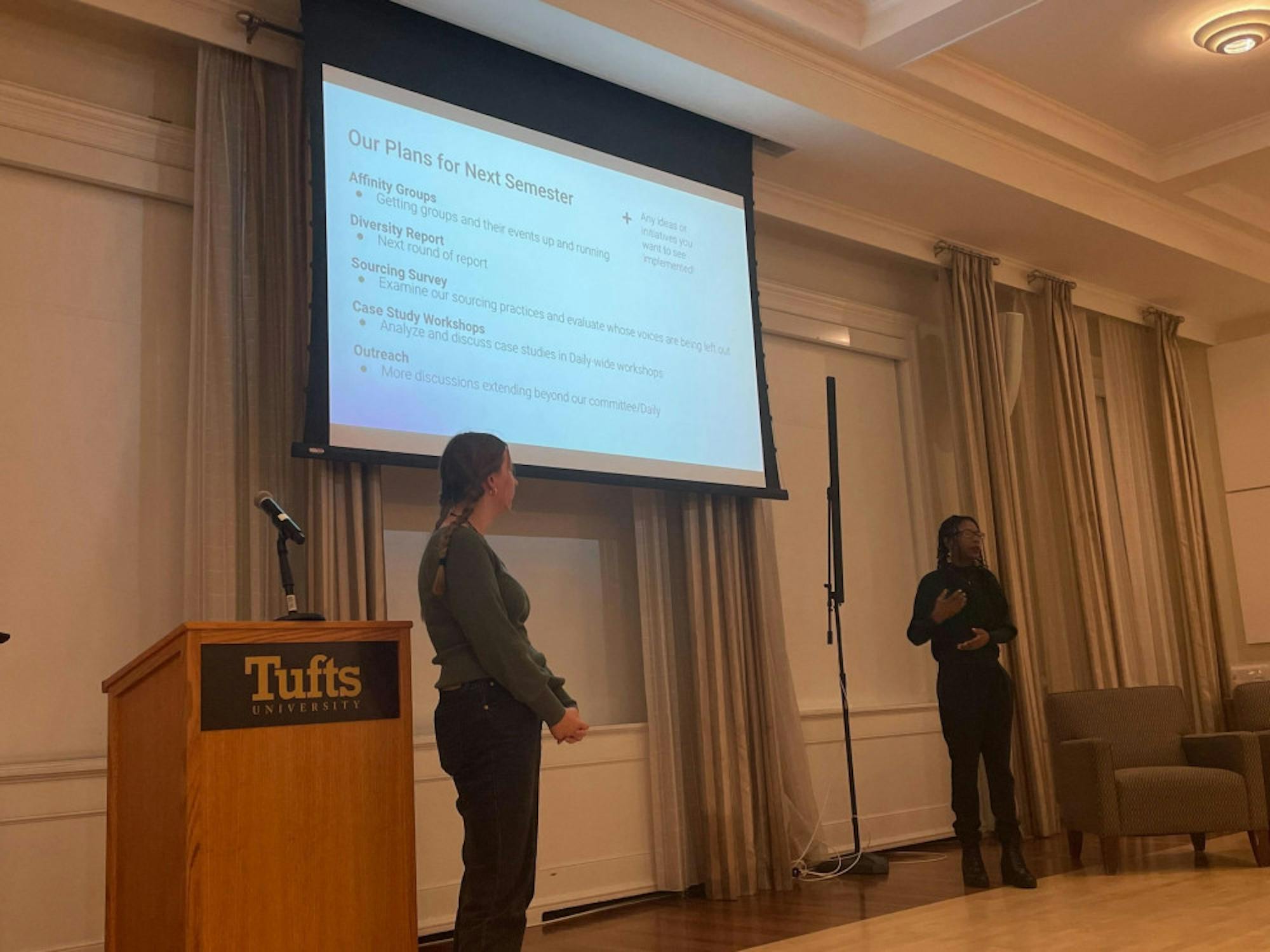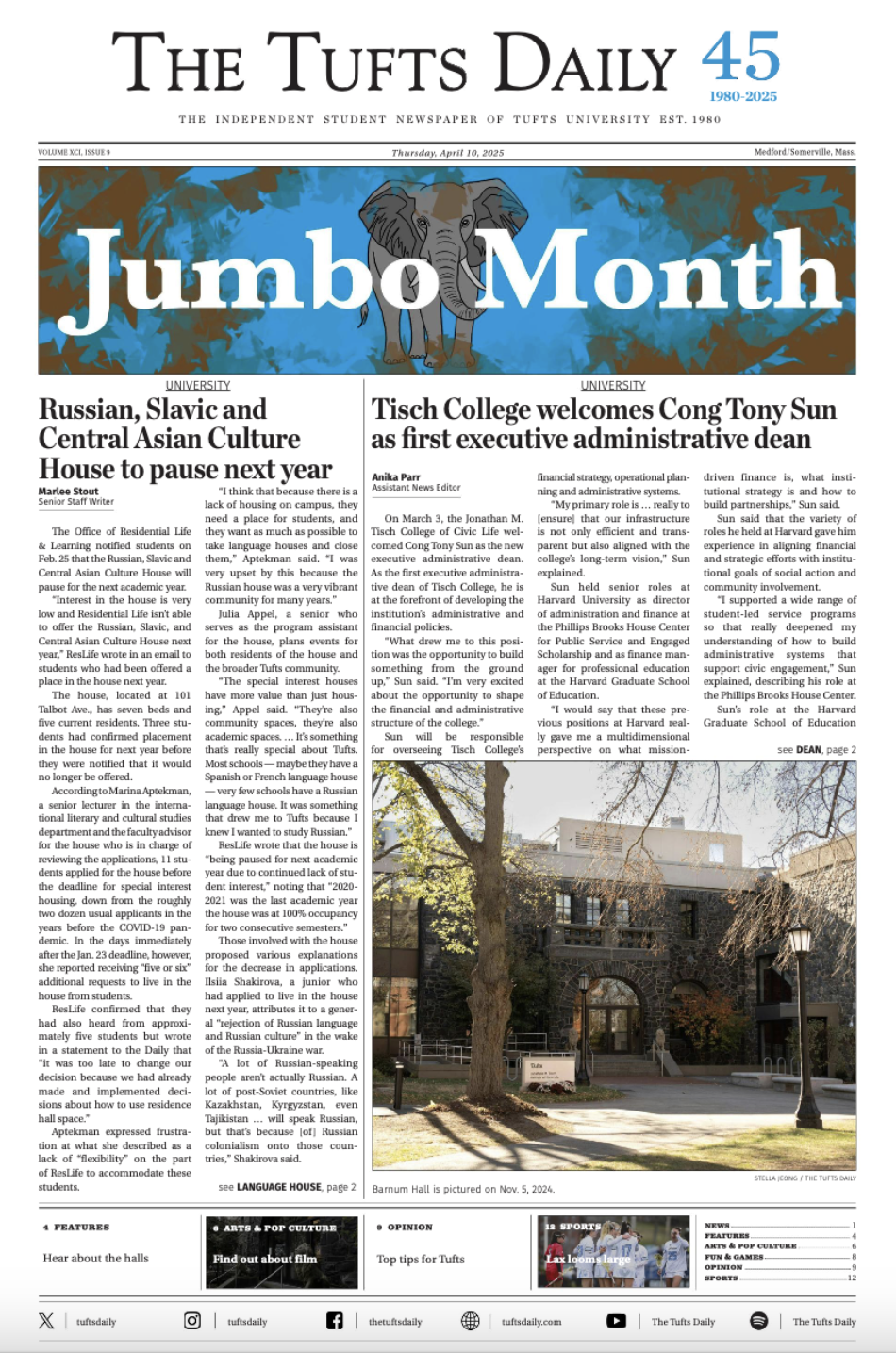Editor’s note: The Daily’s editorial department acknowledges that this article is premised on a conflict of interest. This article is a special feature for Daily Week that does not represent the Daily’s standard journalistic practices.
For Tufts Daily staff members, it should come as no surprise that a multitude of different eyes and perspectives check over an article before its publication. From correcting grammatical errors to double and even triple-checking facts, there are plenty of diligent editors working behind the scenes to ensure the Daily publishes its best possible work.
What you may not know, however, is that there is a group of students uniquely qualified in reviewing and revising wording to ensure that no exclusionary or problematic language slips through the cracks. This essential revision process is just one of the many progressive actions taken by the Daily’s Intentionality & Inclusivity Committee.
The Intentionality & Inclusivity Committee, more commonly referred to as I&I, consists of a group of students independent of the managing board dedicated to making the Daily as inclusive as possible. According to its mission statement, the committee operates under the goal of ensuring that the Daily’s coverage “is equitable, accurate and contextualized,” devoting careful attention to the representation of identities in both the staff and subject matters of the Daily. Odessa Gaines, one of the spring 2023 I&I co-chairs, elaborated on what exactly the committee does to realize its mission.
“Our big mission statement really boils down to making the Daily community more intentional and inclusive in everything we do. Some of that is internal in terms of … the bonding events we have like the Hunt,” Gaines said. “Last year, [the Hunt was] very exclusive in certain ways to different people in different staff levels.”
According to Gaines, the I&I Committee felt that the Hunt was not as fun for new members, so they brought their concerns to the managing board in order to make the event more inclusive to all staff members. In addition, the I&I Committee seeks to elevate the perspectives of marginalized groups on Tufts campus.
“More external [initiatives are] talking with executives … and editors, and trying to get them to push writers to expand to broader communities. So because it’s Black History Month, we’re really pushing for people to write about the Black communities on campus.”
According to Gaines, I&I functions as a safe space where students can express any concerns they might have regarding inclusivity and accessibility within the Daily. As someone whose identity does not coincide with the predominantly white and straight Tufts Daily staff, Gaines feels that I&I is a means through which they can ensure that their identity, and those of their peers, are respectively portrayed in the Daily’s reporting.
“For me, as a student who does not represent the rest of the Daily in terms of my identity, I think just having this organization where you can express [your] concerns … is the most important thing,” Gaines said. “I think having I&I intentionally go about these actions and understand [that] these people exist and [that] they might have different views … just makes everything so much easier for people to feel welcome with the I&I space and the Daily space as a whole.”
In addition to fostering a community among members of the Daily and encouraging writers to broaden their subject matters, the I&I Committee also engages in what Gaines dubs as “ethical” revisions, in which the committee examines any wording that may be perceived as exclusive or hurtful by Daily readers. This review process is integral in ensuring that the Daily does not stray from its core values of inclusive and accurate reporting.
“We fact check certain articles [that] might have weirdly worded language,” Gaines said. “We usually get sent those articles [and] we give our input [on] how to rewrite something to make it sound more sensitive to everybody else.”
Sophomore Avery Hanna, an I&I project member and former co-chair, expressed a similar sentiment regarding the importance of the I&I reviewal process. As a member of a committee dedicated to promoting equity within student journalism, Hanna needs to consider multiple factors when determining if an article is suited for publication, including questions of whose voices are amplified and what implications the subject matter has for the broader community.
“A lot of times, [the managing board] will reach out to us and ask us to look over an article,” Hanna said. “We try [to] be mindful and look through like, what are we publishing? Are we doing a good job of covering a wide range of student voices?”
However, to fully realize the mission of promoting equitable journalism, the I&I Committee knew it was not enough to simply amplify diverse voices and subject matters; the Daily also needs a diverse population of journalists, each of whom brings their own unique perspective and background to the articles they write. In order to analyze the demographics of the Daily staff, a group of students spearheaded the creation of a Diversity & Inclusion Report Committee to draft a report during the summer of 2021. This committee is a team entirely dedicated to retrieving and publishing data on the Daily staff’s identities and experiences.
As this was the first iteration of a Tufts Daily Diversity & Inclusion Report, the committee faced the daunting challenge of determining which categories to include in the questionnaire. Ethan Steinberg, former managing editor and member of the 2021–22 Diversity & Inclusion Report Committee, explained how the committee decided which questions would be included. Not only did the committee look to other collegiate reports such as The Daily Princetonian and The Stanford Daily, but they also brainstormed their own questions that they hoped would produce both interesting and beneficial data points.
“The end goal of this all was to be able to create a list of actionable items that could be implemented by Daily staff and that could ultimately make the [Daily’s] coverage better and more inclusive, and also make the organization itself a more inclusive and welcoming space for staff,” Steinberg said. “We had that goal in mind and tried to extrapolate from that goal which metrics would be most interesting and most useful to have.”
Operating under I&I, this committee released a survey to the Daily staff in November 2021 containing questions on a plethora of different subject matters, including race, sexual orientation and even household income. As responses poured in, the next step for the committee was to analyze the responses and formulate a cohesive report that both highlights the Daily’s issues and offers recommendations to remedy them. Hanna and Gaines were both involved in the qualitative coding of the report, reviewing survey responses and brainstorming tangible solutions that the managing board could implement to foster a more diverse community of journalists.
One data point that struck the committee as particularly concerning was the underrepresentation of low-income students and students on financial aid. In the survey, 57% of Daily staff indicated that their annual household income was higher than $250,000 and around 80% indicated that they were not on financial aid. According to Hanna, this data indicated to the I&I that changes were necessary to bolster low-income students within the Daily.
“We collected all this data [and] we [saw that] there’s really big gaps in economic classes within the Daily,” Hanna said. “There’s a lot of really wealthy people [so] how do we get more lower income students involved? How do we get more accessible to people?”
To tackle this imbalance within the Daily population, the student-run newspaper began fundraising for financial stipends that Daily staff members can apply for, making journalism a more feasible prospect for low-income students. For Steinberg, tangible action like these stipends indicate just how valuable the 2021–22 Diversity & Inclusion Report is.
“[The Diversity Report] already has helped to hold the staff and the leadership accountable for implementing changes and for making the Daily . . . [an] even more welcoming and inclusive space,” Steinberg said. “It gives us a space to reflect back on what was accomplished and what still needs work.”
Looking ahead, the Diversity & Inclusion Report Committee plans on publishing a new report every academic school year, marking a new trend of equitable progress within the Daily. This data will allow the I&I Committee to continue the conversation about equitable journalism within the Daily and to reach their goal of better representing the diverse backgrounds and identities of the Tufts student population.
“By having more preemptive and active conversations about areas like intentionality and inclusivity, we can make sure when problems … arise, that we’re well informed and prepared to address them in the best possible way,” Hanna said. “We’re students trying to learn, and by having intentionality and inclusivity committees … we’re able to make sure we’re learning across all areas and producing well-rounded, well-prepared journalists.”






